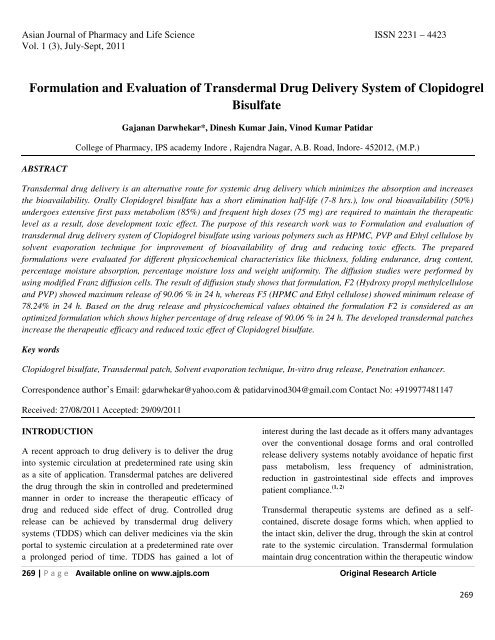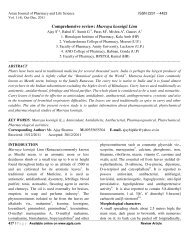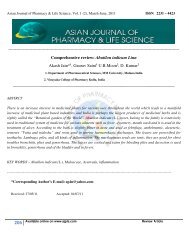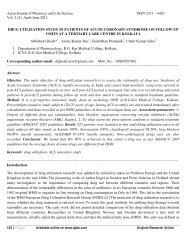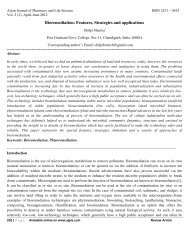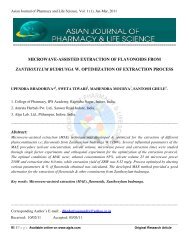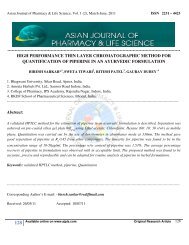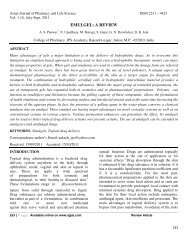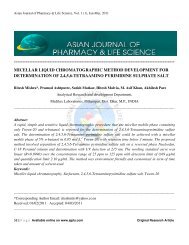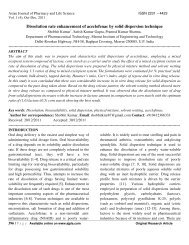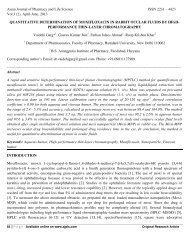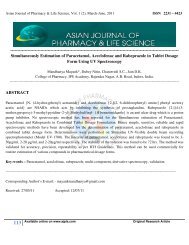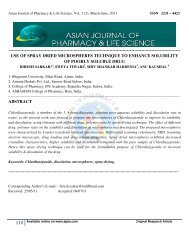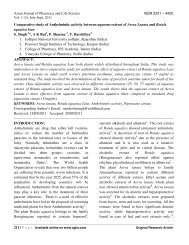Formulation and Evaluation of Transdermal Drug Delivery System of ...
Formulation and Evaluation of Transdermal Drug Delivery System of ...
Formulation and Evaluation of Transdermal Drug Delivery System of ...
You also want an ePaper? Increase the reach of your titles
YUMPU automatically turns print PDFs into web optimized ePapers that Google loves.
Asian Journal <strong>of</strong> Pharmacy <strong>and</strong> Life Science ISSN 2231 – 4423<br />
Vol. 1 (3), July-Sept, 2011<br />
<strong>Formulation</strong> <strong>and</strong> <strong>Evaluation</strong> <strong>of</strong> <strong>Transdermal</strong> <strong>Drug</strong> <strong>Delivery</strong> <strong>System</strong> <strong>of</strong> Clopidogrel<br />
Bisulfate<br />
ABSTRACT<br />
Gajanan Darwhekar*, Dinesh Kumar Jain, Vinod Kumar Patidar<br />
College <strong>of</strong> Pharmacy, IPS academy Indore , Rajendra Nagar, A.B. Road, Indore- 452012, (M.P.)<br />
<strong>Transdermal</strong> drug delivery is an alternative route for systemic drug delivery which minimizes the absorption <strong>and</strong> increases<br />
the bioavailability. Orally Clopidogrel bisulfate has a short elimination half-life (7-8 hrs.), low oral bioavailability (50%)<br />
undergoes extensive first pass metabolism (85%) <strong>and</strong> frequent high doses (75 mg) are required to maintain the therapeutic<br />
level as a result, dose development toxic effect. The purpose <strong>of</strong> this research work was to <strong>Formulation</strong> <strong>and</strong> evaluation <strong>of</strong><br />
transdermal drug delivery system <strong>of</strong> Clopidogrel bisulfate using various polymers such as HPMC, PVP <strong>and</strong> Ethyl cellulose by<br />
solvent evaporation technique for improvement <strong>of</strong> bioavailability <strong>of</strong> drug <strong>and</strong> reducing toxic effects. The prepared<br />
formulations were evaluated for different physicochemical characteristics like thickness, folding endurance, drug content,<br />
percentage moisture absorption, percentage moisture loss <strong>and</strong> weight uniformity. The diffusion studies were performed by<br />
using modified Franz diffusion cells. The result <strong>of</strong> diffusion study shows that formulation, F2 (Hydroxy propyl methylcellulose<br />
<strong>and</strong> PVP) showed maximum release <strong>of</strong> 90.06 % in 24 h, whereas F5 (HPMC <strong>and</strong> Ethyl cellulose) showed minimum release <strong>of</strong><br />
78.24% in 24 h. Based on the drug release <strong>and</strong> physicochemical values obtained the formulation F2 is considered as an<br />
optimized formulation which shows higher percentage <strong>of</strong> drug release <strong>of</strong> 90.06 % in 24 h. The developed transdermal patches<br />
increase the therapeutic efficacy <strong>and</strong> reduced toxic effect <strong>of</strong> Clopidogrel bisulfate.<br />
Key words<br />
Clopidogrel bisulfate, <strong>Transdermal</strong> patch, Solvent evaporation technique, In-vitro drug release, Penetration enhancer.<br />
Correspondence author’s Email: gdarwhekar@yahoo.com & patidarvinod304@gmail.com Contact No: +919977481147<br />
Received: 27/08/2011 Accepted: 29/09/2011<br />
INTRODUCTION<br />
A recent approach to drug delivery is to deliver the drug<br />
into systemic circulation at predetermined rate using skin<br />
as a site <strong>of</strong> application. <strong>Transdermal</strong> patches are delivered<br />
the drug through the skin in controlled <strong>and</strong> predetermined<br />
manner in order to increase the therapeutic efficacy <strong>of</strong><br />
drug <strong>and</strong> reduced side effect <strong>of</strong> drug. Controlled drug<br />
release can be achieved by transdermal drug delivery<br />
systems (TDDS) which can deliver medicines via the skin<br />
portal to systemic circulation at a predetermined rate over<br />
a prolonged period <strong>of</strong> time. TDDS has gained a lot <strong>of</strong><br />
interest during the last decade as it <strong>of</strong>fers many advantages<br />
over the conventional dosage forms <strong>and</strong> oral controlled<br />
release delivery systems notably avoidance <strong>of</strong> hepatic first<br />
pass metabolism, less frequency <strong>of</strong> administration,<br />
reduction in gastrointestinal side effects <strong>and</strong> improves<br />
(1, 2)<br />
patient compliance.<br />
<strong>Transdermal</strong> therapeutic systems are defined as a selfcontained,<br />
discrete dosage forms which, when applied to<br />
the intact skin, deliver the drug, through the skin at control<br />
rate to the systemic circulation. <strong>Transdermal</strong> formulation<br />
maintain drug concentration within the therapeutic window<br />
269 | P a g e Available online on www.ajpls.com Original Research Article<br />
269
Asian Journal <strong>of</strong> Pharmacy <strong>and</strong> Life Science ISSN 2231 – 4423<br />
Vol. 1 (3), July-Sept, 2011<br />
for prolong period <strong>of</strong> time ensuring that drug levels neither<br />
fall below the minimum effective concentration nor exceed<br />
the maximum effective concentration. An ideal drug to be<br />
formulated as transdermal drug delivery should possess<br />
several physico-chemical properties, such as short halflife,<br />
small molecular size, low dose, low oral<br />
bioavailability, etc. 3<br />
Clopidogrel bisulfate is a Anti platelet drug, undergoes<br />
hepatic first pass metabolism <strong>and</strong> low oral bioavailability<br />
(50%). 4 Hence it is suitable for formulation as a<br />
transdermal patch. <strong>Drug</strong> molecules in contact with the skin<br />
surface can penetrate by three potential pathways: through<br />
the sweat ducts, via the hair follicles <strong>and</strong> sebaceous gl<strong>and</strong>s<br />
(collectively called the shunt or appendageal route), or<br />
directly across the stratum corneum. (5)<br />
MATERIAL AND METHODS<br />
Material<br />
Clopidogrel bisulfate was obtained as a gift samples from<br />
Ipca laboratories Ratlam. Poly vinyl pyrolidone, hydroxy<br />
propyl methylcellulose <strong>and</strong> Ethyl cellulose were purchased<br />
from LOBA chem. LTD Mumbai (India). PEG 400 was<br />
purchased from S.D Fine chemical Ltd. (Mumbai, India).<br />
All other laboratory chemicals used in the study were <strong>of</strong><br />
analytical reagents grade.<br />
Partition coefficient determination<br />
The partition coefficient (log D) is a measurement <strong>of</strong><br />
lipophilicity <strong>of</strong> molecules, which can be used to predict its<br />
capability to cross biological membrane. The Partition<br />
coefficient studies were performed using n-octanol/skin as<br />
non aqueous phase <strong>and</strong> water as aqueous phase. The two<br />
phases were mixed in equal quantities <strong>and</strong> kept for<br />
saturation with each other in separating funnel. After<br />
mixing the system remain undisturbed for half an hour.<br />
About 10 mg <strong>of</strong> drug added to this solution <strong>and</strong> was<br />
shaken occasionally in separating funnel. After shaken the<br />
resulting solution was kept a site for 24 hour.<br />
After 24 hour two phases were separated in a separating<br />
funnel. The aqueous phase was filtered through Whatman<br />
filter paper, suitably diluted <strong>and</strong> amount <strong>of</strong> Clopidogrel<br />
bisulfate in aqueous phase was determined by measuring<br />
absorbance at 220 nm using UV spectrophotometer<br />
(Shimadzu 160). The partition coefficient <strong>of</strong> Clopidogrel<br />
Bisulfate was calculated from the ratio between the<br />
concentration <strong>of</strong> Clopidogrel Bisulfate in organic <strong>and</strong><br />
aqueous phases from the below mentioned formula. (7)<br />
Permeation study <strong>of</strong> pure drug<br />
The in-vitro drug permeation studies were carried out by<br />
using Franz diffusion cell. The rat skin <strong>of</strong> abdominal part<br />
was cut <strong>and</strong> hair was removed <strong>and</strong> clamped between the<br />
receptor <strong>and</strong> donor compartments. The receptor<br />
compartment was filled with 15 ml <strong>of</strong> diffusion medium<br />
(Phosphate buffer pH 7.4) through sampling port taking<br />
care to remove all the air bubbles. The contents were<br />
stirred at 500 rpm. by externally driven, teflon coated<br />
small magnetic bead to keep them well mixed. The<br />
temperature <strong>of</strong> the system was maintained at 37.0±2 0 C.<br />
Accurately weighed 5 mg <strong>of</strong> clopidogrel bisulfate was<br />
dissolved in phosphate buffer pH 7.4 <strong>and</strong> placed in<br />
receptor compartment. At suitable time intervals, aliquots<br />
(3ml) were collected <strong>and</strong> suitable diluting the aliquot with<br />
phosphate buffer <strong>and</strong> absorbance was measuring at 220 nm<br />
using a double beam UV spectrophotometer (Shimadzu<br />
160). The diffusion medium <strong>of</strong> the same volume (3ml),<br />
which was pre warmed at 37 0 C, was then replaced into the<br />
receptor compartment. Duration <strong>of</strong> the experiment was 12-<br />
24 hours. The amount <strong>of</strong> drug permeated through skin was<br />
calculated from absorbance <strong>of</strong> aliquots.<br />
Preparation <strong>of</strong> transdermal patch<br />
<strong>Transdermal</strong> patches <strong>of</strong> clopidogrel bisulfate were<br />
prepared by solvent casting technique (Table 1). Ethanolic<br />
solution <strong>of</strong> polymer <strong>and</strong> drug along with polyethylene<br />
270 | P a g e Available online on www.ajpls.com Original Research Article<br />
270
Asian Journal <strong>of</strong> Pharmacy <strong>and</strong> Life Science ISSN 2231 – 4423<br />
Vol. 1 (3), July-Sept, 2011<br />
glycol (plasticizer) was prepared. The homogenous<br />
mixture was poured into plastic mould. The solvent was<br />
allowed to evaporate at controlled rate by placing an<br />
inverted funnel over the plastic mould. The control <strong>of</strong><br />
evaporation is necessary for uniform drying <strong>of</strong> films. The<br />
drying was carried out at room temperature for duration <strong>of</strong><br />
24 hours. After 24 hours the dry films was removed from<br />
plastic mould <strong>and</strong> stored in desiccators until used. (6,7)<br />
Percentage Moisture uptake<br />
The weighed films were kept in a desiccators at room<br />
temperature for 24hrs containing saturated solution <strong>of</strong><br />
potassium chloride in order to maintain 84% RH. After<br />
24hrs the films are to be reweighed <strong>and</strong> determine the<br />
percentage moisture uptake from the below mentioned<br />
formula. (8,9,10)<br />
Thickness <strong>of</strong> the patch<br />
The thickness <strong>of</strong> the drug loaded patch was measured in<br />
different points by using a digital micrometer <strong>and</strong><br />
determines the average thickness <strong>and</strong> st<strong>and</strong>ard deviation<br />
for the same to ensure the thickness <strong>of</strong> the prepared patch.<br />
(8)<br />
Weight uniformity<br />
The prepared patches were dried at 60°c for 4hrs before<br />
testing. A specified area <strong>of</strong> patch was cut in different parts<br />
<strong>of</strong> the patch <strong>and</strong> weigh in digital balance. The average<br />
weight <strong>and</strong> st<strong>and</strong>ard deviation values are to be calculated<br />
from the individual weight. (8,9)<br />
Folding endurance<br />
A strip <strong>of</strong> specific area was cut evenly <strong>and</strong> repeatedly<br />
folded at the same place till it broke. The number <strong>of</strong> times<br />
the film could be folded at the same place without<br />
breaking gave the value <strong>of</strong> the folding endurance. (10)<br />
Percentage Moisture content<br />
The prepared films were weighed individually <strong>and</strong> to be<br />
kept in a desiccators containing fused calcium chloride at<br />
room temperature for 24 hrs. After 24hrs the films are to<br />
be reweighed <strong>and</strong> determine the percentage moisture<br />
content from the below mentioned formula. (8,9,10)<br />
Water vapor permeability<br />
Glass vials <strong>of</strong> 5 ml capacity were washed thoroughly <strong>and</strong><br />
dried to a constant weight in an oven. About 1gm <strong>of</strong> fused<br />
Calcium chloride was taken in the vials & the polymer<br />
films were fixed over the brim with the help <strong>of</strong> an adhesive<br />
tape. Then the vials were weighed <strong>and</strong> stored in a humidity<br />
chamber at 85 % RH condition for a period <strong>of</strong> 24 hours.<br />
The vials were removed <strong>and</strong> weighed at various time<br />
intervals like 3, 6, 12, 18 <strong>and</strong> 24hrs to note down the<br />
weight gain. (11)<br />
<strong>Drug</strong> content<br />
A specified area <strong>of</strong> patch was dissolved in a suitable<br />
solvent in specific volume. Then the solution is to be<br />
filtered through a filter medium <strong>and</strong> analyze the drug<br />
contain with the suitable method (UV or HPLC technique).<br />
(11,12)<br />
Percentage Elongation break test<br />
The percentage elongation break was determined by noting<br />
the length just before the break point, the percentage<br />
elongation can be determined from the below mentioned<br />
formula: (12)<br />
Where, L1is the final length <strong>of</strong> each strip <strong>and</strong> L2 is the<br />
initial length <strong>of</strong> each strip.<br />
271 | P a g e Available online on www.ajpls.com Original Research Article<br />
271
Asian Journal <strong>of</strong> Pharmacy <strong>and</strong> Life Science ISSN 2231 – 4423<br />
Vol. 1 (3), July-Sept, 2011<br />
In vitro drug diffusion studies<br />
The in vitro diffusion study was carried out with the<br />
abdominal rate skin using Franz diffusion cell. The<br />
cylinder consists <strong>of</strong> two chambers, the donor <strong>and</strong> the<br />
receptor compartment. The donor compartment was open<br />
at the top <strong>and</strong> was exposed to atmosphere. The temperature<br />
was maintained at 37 ± 0.5 o C <strong>and</strong> receptor compartment<br />
was provided with sampling port. The diffusion medium<br />
used was phosphate buffer (pH 7.4).<br />
The diffusion studies were done to get an idea <strong>of</strong><br />
permeation <strong>of</strong> drug through barrier from the transdermal<br />
system. In vitro studies are also done for TDDS<br />
development.<br />
Usually, two types <strong>of</strong> diffusion cells are used as horizontal<br />
<strong>and</strong> vertical. The Franz <strong>and</strong> Keshary Chien (K-C) type <strong>of</strong><br />
diffusion cells are <strong>of</strong> horizontal type <strong>of</strong> cells. In this work,<br />
K-C type <strong>of</strong> diffusion cell was used. Diffusion cells<br />
generally comprise two compartments, one containing the<br />
active component (donor compartment) <strong>and</strong> the other<br />
containing receptor solution (receptor compartment),<br />
separated by barrier i.e. albino rate abdominal skin.<br />
The cell consisted <strong>of</strong> sampling port <strong>and</strong> temperature<br />
maintaining jacket. The outlet <strong>and</strong> inlet was connected<br />
with latex tube so the jacket had stagnant water inside <strong>and</strong><br />
heat was provided by hot plate. The stainless steel pin was<br />
used to stir the receptor solution using magnetic stirrer.<br />
The mice abdominal skin was placed on receptor<br />
compartment <strong>and</strong> both compartments held tight by clamps.<br />
Phosphate buffer pH 7.4 was used as receptor solution.<br />
The volume <strong>of</strong> diffusion cell was 15 ml <strong>and</strong> stirred with<br />
bent stainless steel pin. The temperature was maintained at<br />
37 ± 2°C with the help <strong>of</strong> magnetic stirrer. The diffusion<br />
was carried out for 24 hours <strong>and</strong> 1 ml sample was<br />
withdrawn at an interval <strong>of</strong> 1, 2, 3, 4, 5, 6, 7, 8, 10, 12 <strong>and</strong><br />
24 hour. The same volume <strong>of</strong> phosphate buffer pH 7.4 was<br />
added to receptor compartment to maintain sink conditions<br />
<strong>and</strong> the samples were analyzed at 220nm in UV<br />
spectrophotometer. (8,10)<br />
RESULT AND DISCUSSION<br />
In the present work efforts have been made to prepare<br />
transdermal drug delivery system <strong>of</strong> Clopidogrel<br />
bisulphate using the polymers HPMC, EC <strong>and</strong> PVP, using<br />
polyethylene glycol as a plasticizer by solvent casting<br />
technique. The selection <strong>of</strong> polymer combinations<br />
produces clear, smooth, uniform, substantive, flexible <strong>and</strong><br />
desired thickness film for the transdermal drug delivery<br />
systems <strong>of</strong> Clopidogrel bisulphate. The prepared<br />
formulation were evaluated for different Physico-chemical<br />
characteristics such as Thickness, Folding endurance, <strong>Drug</strong><br />
Content, Percent moisture absorption, Percentage moisture<br />
loss <strong>and</strong> Weight uniformity. The release characteristics <strong>of</strong><br />
the formulation were studied in in-vitro conditions. In vitro<br />
dissolution studies were carried out in phosphate buffer<br />
(pH 7.4) for 24 hours. The partition coefficient <strong>of</strong> the<br />
clopidogrel bisulfate was found to be 2.1. After 24 hour<br />
68.11 % drug was permeated through skin.<br />
The thickness <strong>of</strong> the patches varied from 0.125 to<br />
0.246mm. The minimum st<strong>and</strong>ard deviation values<br />
assumed that the process used for preparing the drug<br />
delivery system is capable <strong>of</strong> giving reproducible result.<br />
As the concentration <strong>of</strong> PVP <strong>and</strong> Ethyl cellulose increase,<br />
moisture content <strong>of</strong> patches was also increase. <strong>Formulation</strong><br />
F1 (3.01±0.057) absorbed highest amount <strong>of</strong> moisture<br />
which also revealed its high hydrophilicity <strong>and</strong><br />
formulation F6 (1.28±0.042) absorb least amount <strong>of</strong><br />
moisture.<br />
The folding endurance was measured manually, films were<br />
folded 72 times maximum in <strong>Formulation</strong> F2 <strong>and</strong> if the<br />
film shows any cracks it was taken as end point. The<br />
folding endurance was better in F2 formulation.<br />
As the concentration <strong>of</strong> PVP <strong>and</strong> Ethyl cellulose increase,<br />
moisture uptake <strong>of</strong> patches was also increase. The highest<br />
moisture absorption was found in the formulation F6 <strong>and</strong><br />
lowest value <strong>of</strong> moisture absorption was found in the<br />
formulation F1.<br />
272 | P a g e Available online on www.ajpls.com Original Research Article<br />
272
Asian Journal <strong>of</strong> Pharmacy <strong>and</strong> Life Science ISSN 2231 – 4423<br />
Vol. 1 (3), July-Sept, 2011<br />
The drug content uniformity <strong>of</strong> the prepared formulation<br />
have shown that the process used to prepared the<br />
transdermal film in this study was capable <strong>of</strong> giving film<br />
with uniform drug content. The result <strong>of</strong> drug content<br />
indicates that drug is uniformly dispersed in formulation.<br />
Water vapour transmission study determines the<br />
permeability characteristics <strong>of</strong> the patches. The result <strong>of</strong><br />
water vapour transmission study reviled that all the<br />
formulation are permeable to water vapour.<br />
In vitro drug release studies were carried out for the<br />
different formulations using French diffusion cell. The<br />
medicated films showed drug Release study in %<br />
cumulative release. The relationship can be established as<br />
F2 >F1 > F3>F6>F4>F5Thus, by varying amount <strong>of</strong><br />
polymer in film, percent release can be varied. <strong>Drug</strong>polymer<br />
affinity can be major factor that control release <strong>of</strong><br />
drug from formulation.<br />
Maximum percentage <strong>of</strong> drug release (i.e.90.06%) was<br />
observed with formulation F2 <strong>and</strong> the minimum (i.e.<br />
78.24%) was found with formulation F5. The addition <strong>of</strong><br />
hydrophilic components such as PVP in to the formulation<br />
tends to enhance its release-rate constants. This outcome<br />
can be attributed to the leaching <strong>of</strong> the soluble component,<br />
TABLE 1: Composition <strong>of</strong> transdermal patches<br />
which leads to the formation <strong>of</strong> pores <strong>and</strong> thus a decrease<br />
in the mean diffusion path length <strong>of</strong> drug molecules to<br />
release into the dissolution medium. The result is higher<br />
dissolution rates. Substances such as PVP act as<br />
antinucleating agents that retard the crystallization <strong>of</strong> a<br />
drug. Thus they play a significant role in improving the<br />
solubility <strong>of</strong> a drug in the matrix by sustaining the drug in<br />
an amorphous form so that it undergoes rapid<br />
solubilization by penetration <strong>of</strong> the dissolution medium.<br />
CONCLUSION<br />
The prepared transdermal drug delivery system <strong>of</strong><br />
Clopidogrel bisulfate using different polymers such as<br />
HPMC, EC <strong>and</strong> PVP had shown good promising results<br />
for all the evaluated parameters. Based on the In-vitro drug<br />
release <strong>and</strong> drug content Result, formulation F2 was<br />
concluded as an optimized formulation, which shows its<br />
higher percentage <strong>of</strong> drug release.<br />
ACKNOWLEDGEMENTS<br />
The authors are thankful to College <strong>of</strong> Pharmacy, IPS<br />
Academy Indore for providing all the facilities to carry out<br />
this research work. They are also thankful to IPCA<br />
laboratories Ratlam for providing gift sample <strong>of</strong><br />
Clopidogrel bisulfate for research purpose.<br />
Ingradient<br />
<strong>Formulation</strong> Batches<br />
F1 F2 F3 F4 F5 F6<br />
Clopidogrel Bisulfate (mg) 37 37 37 37 37 37<br />
HPMC (mg) 300 300 300 300 300 300<br />
EC (mg) 100 150 200 - - -<br />
PVP (mg) - - - 100 150 200<br />
Ethanol (ml) 5 5 5 5 5 5<br />
PEG 400 (ml) 0.4 0.4 0.4 0.4 0.4 0.4<br />
273 | P a g e Available online on www.ajpls.com Original Research Article<br />
273
Asian Journal <strong>of</strong> Pharmacy <strong>and</strong> Life Science ISSN 2231 – 4423<br />
Vol. 1 (3), July-Sept, 2011<br />
TABLE 2: Partition coefficient <strong>of</strong> drug in PBS 7.4<br />
Partition coefficient <strong>of</strong> drug Solvent system Log D Values<br />
Clopidogrel bisulfate Phosphate buffer: n-octanol 2.1 ± 0.03<br />
TABLE 3: Partition coefficient <strong>of</strong> drug in skin<br />
Partition coefficient <strong>of</strong> drug Solvent system Log D Values<br />
Clopidogrel bisulfate Phosphate buffer: skin 2.4 ± 0.04<br />
TABLE 4: Permeation study <strong>of</strong> clopidogrel bisulfate in phosphate buffer pH 7.4<br />
S. No. Time (hrs.) %Amt. permeation<br />
1 0 0<br />
2 1 7.03<br />
3 2 12.15<br />
4 3 19.27<br />
5 4 25.26<br />
6 5 34.37<br />
7 6 41.97<br />
8 8 48.44<br />
7 10 56.70<br />
8 12 61.24<br />
9 24 68.11<br />
274 | P a g e Available online on www.ajpls.com Original Research Article<br />
274
Asian Journal <strong>of</strong> Pharmacy <strong>and</strong> Life Science ISSN 2231 – 4423<br />
Vol. 1 (3), July-Sept, 2011<br />
TABLE 5: Physico-chemical properties <strong>of</strong> prepared formulations<br />
<strong>Formulation</strong><br />
Code<br />
Thickness (mm)<br />
± S.D<br />
Weight uniformity<br />
(mg)<br />
Folding<br />
endurance<br />
± S.D<br />
Moisture content<br />
(%) ± S.D<br />
F1 0.155 ± 0.0075 96±5.130 45±2.4 3.01±0.057<br />
F2 0.174 ± 0.0079 104±3.06 72± 3.1 2.43±0.038<br />
F3 0. 232± 0.0040 110±2.51 51 ±2.8 2.25±0.073<br />
F4 0.192 ± 0.0090 116±3.05 39 ± 4.4 1.85±0.031<br />
F5 0.148 ± 0.0091 125±2.08 57 ±1.8 1.72±0.053<br />
F6 0.246 ± 0.0079 135±3.51 45 ±2.1 1.28±0.042<br />
TABLE 6: Physio-chemical properties <strong>of</strong> prepared formulations<br />
<strong>Formulation</strong><br />
code<br />
Moisture uptake ±<br />
S.D<br />
Percent elongation break<br />
test ± S.D<br />
cumulative drug<br />
release (% )<br />
Water vapor<br />
transmission test ±<br />
S.D<br />
F1 1.32±1.01 75.0% 85.22 0.22 ± 0.024<br />
F2 1.52±1.27 93.3% 90.06 0.40 ± 0.031<br />
F3 1.58±1.21 102.5% 83.92 0.56 ± 0.038<br />
F4 2.05±1.76 84. 17% 80.68 0.36 ± 0.016<br />
F5 2.10±1.83 94.17% 78.24 0.60 ± 0.027<br />
F6 2.51±1.92 114.16% 81.61 0.78 ± 0.041<br />
275 | P a g e Available online on www.ajpls.com Original Research Article<br />
275
Asian Journal <strong>of</strong> Pharmacy <strong>and</strong> Life Science ISSN 2231 – 4423<br />
Vol. 1 (3), July-Sept, 2011<br />
TABLE 7: <strong>Drug</strong> content <strong>of</strong> prepared formulations<br />
<strong>Formulation</strong> code<br />
<strong>Drug</strong> content(%)<br />
F1 89±0.3<br />
F2 92±0.1<br />
F3 85±0.6<br />
F4 86±0.2<br />
F5 83±0.4<br />
F6 90±0.5<br />
TABLE 8: Curve fitting data for the release rate<br />
pr<strong>of</strong>ile <strong>of</strong> formulation F2<br />
Fig 2. Thickness <strong>of</strong> various batches.<br />
Model<br />
r 2 value<br />
Krosmeyers – peppas 0.9984<br />
Zero order 0.8064<br />
First order 0.1534<br />
Higuchi matrix 0.5154<br />
Hixson Crowel -0.9548<br />
Fig 3. Folding endurance <strong>of</strong> various batches.<br />
Fig 1. Comparative In vitro drug release <strong>of</strong> clopidogrel<br />
bisulfate in TDDS <strong>Formulation</strong><br />
Fig. 4 Moisture content study <strong>of</strong> various batches.<br />
276 | P a g e Available online on www.ajpls.com Original Research Article<br />
276
Asian Journal <strong>of</strong> Pharmacy <strong>and</strong> Life Science ISSN 2231 – 4423<br />
Vol. 1 (3), July-Sept, 2011<br />
Fig. 5 Moisture uptack study <strong>of</strong> various batches.<br />
Fig. 6 Water vapour transmission study <strong>of</strong> formulated<br />
batches.<br />
Fig. 7 <strong>Drug</strong> Content study <strong>of</strong> formulated batches.<br />
2. Jain, N.K., Controlled <strong>and</strong> Novel drug delivery. CBS<br />
Publisher <strong>and</strong> distributor, 1 st ed., 1997; 100-126.<br />
3. Gannu, R., Vamshi, Y.V., Kishan V., Rao, Y.M.,<br />
Development <strong>of</strong> Nitrendipine transdermal Patches:<br />
In vitro <strong>and</strong> Ex vivo Characterization. Current<br />
<strong>Drug</strong> <strong>Delivery</strong>, 2007; 4, 69-76.<br />
4. Clark’s Analysis <strong>of</strong> <strong>Drug</strong>s <strong>and</strong> Poisons,<br />
Pharmaceutical Press, 3 rd edition, 2004; 2,834.<br />
5. Barry, B.W., <strong>Drug</strong> delivery route in skin: a novel<br />
approach. Adv. <strong>Drug</strong> <strong>Delivery</strong> Review. 2002; 54 Suppl.<br />
1, S31-S40.<br />
6. Rajesh, N., Siddaramaiah, Gowda, D.V.,<br />
Somashekar. C.N., <strong>Formulation</strong> <strong>and</strong> evaluation <strong>of</strong><br />
biopolymer based transdermal drug delivery, Int.<br />
J. Pharmacy Pharm. Sci., 2010; 2, 142-147<br />
7. Vijayan, V., Sumanth, M.H., Suman, L., vinay, T.,<br />
Srinivasrao, D., Kumar. K.J., Development <strong>and</strong><br />
physiochemical, in-vitro evaluation <strong>of</strong><br />
Antihypertensive transdermal Patches. J. Pharm.<br />
Sci. & Res., 2010; 2(3), 171-177.<br />
8. Shivaraj, A. Selvam, R.P., Mani, T.T., Sivakumar,<br />
T., Design <strong>and</strong> evaluation <strong>of</strong> transdermal drug<br />
delivery <strong>of</strong> ketotifen fumarate, Int. J. Pharm.<br />
Biomed. Res. 2010; 1(2), 42-47.<br />
9. Bharkatiya, M., Nema, R.K., Design <strong>and</strong><br />
characterization <strong>of</strong> drug free patches for<br />
transdermal application, Int. J. Pharm, Sci., 2010;<br />
2 (1), 35-39.<br />
10. Ramkanth. S., Alagusundaram M., Gnanaprakash<br />
K., Rao K.M., Mohammed S.T.S., Paneer, K.,<br />
Chetty M.C., Design <strong>and</strong> characterization <strong>of</strong><br />
matrix type transdermal drug delivery <strong>System</strong><br />
using metoprolol tartarate, Int. J. Pharm Res.<br />
2010; 1 (1) 1-5.<br />
11. Sanjoy, m., Thimmasetty, j., Ratan, G.N.,<br />
Kilarimath, B.H., <strong>Formulation</strong> <strong>and</strong> evaluation <strong>of</strong><br />
Crvedilol transdermal patches. Int. Res. J. Pharm.<br />
2011; 2 (1), 237-248.<br />
12. Patel, J.H., Patel, J.S., Desai B.G., Patel, K.D.,<br />
Design <strong>and</strong> <strong>Evaluation</strong> <strong>of</strong> Amlodipin besilate<br />
REFERENCES<br />
1. Robinson, J.R., Lee, H.L., Controlled <strong>Drug</strong> <strong>Delivery</strong><br />
Fundamentals <strong>and</strong> Applications. 2 nd ed., Marcel Decker,<br />
New York. 1987; 524-552.<br />
277 | P a g e Available online on www.ajpls.com Original Research Article<br />
277
Asian Journal <strong>of</strong> Pharmacy <strong>and</strong> Life Science ISSN 2231 – 4423<br />
Vol. 1 (3), July-Sept, 2011<br />
<strong>Transdermal</strong> Patches Containing Film Former. Int.<br />
J. Pharm. Res., Dev. 2009; 7, 1-10.<br />
13. Reddy, B.A., In vitro characterzatioan <strong>and</strong><br />
evaluation <strong>of</strong> transdermal drug delivery system for<br />
Metoprolol tartarate. JPRHC. 2 (4), 325-329.<br />
14. Shaeiwitz, J,A., Turton, R., Design <strong>of</strong> a<br />
transdermal delivery system: A case study in<br />
product design <strong>and</strong> multi-scale design, 2004; 3413.<br />
15. Robinson, J.R., Lee, H.L., Controlled <strong>Drug</strong><br />
<strong>Delivery</strong> Fundamentals <strong>and</strong> Applications, 2nd ed.<br />
Marcel Decker inc; New York. 1987; 205-208.<br />
16. Chien, Y.W. “Novel <strong>Drug</strong> <strong>Delivery</strong> <strong>System</strong>s”,<br />
2nd ed. Marcel Dekker, Inc.,New York, 1987;<br />
301-314.<br />
278 | P a g e Available online on www.ajpls.com Original Research Article<br />
278


